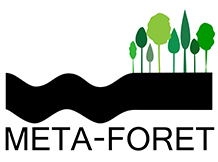1/ Designs of cloaks with artificially anisotropic soils using buried columns and/or forest of trees
Such metamaterial parameters make possible an invisibility cloak for flexural waves (in a plate), but one could envisage similar designs for surface seismic waves. One constraint is that strong anisotropy of the Young’s modulus is required on the inner circular boundary of the elastic cloak, as well as a vanishing density, to force the propagation of flexural waves around a cloaked region [i.e., a disk surrounded by a metamaterial ring ; see Fig. 1(g)]. However, the cloak parameters in Farhat et al. (2009) can also be interpreted in terms of anisotropic effective indices that have a decreasing entry toward the center of the cloak, and a large entry along the direction of its circular boundary.
In the case of the forest of trees in WP3.2 Fig. 1, if the tree length gradually increases toward the inner boundary of the cloak, then the effective refractive index would decrease in the same manner, which partially meets the criteria of the cloak, as noted in Colombi et al. (2015). However, it should be borne in mind that Rayleigh waves have a certain skin depth when they propagate within structured soils. The simplistic plate model of Farhat et al. (2009) will thus require some adjustments to extend the homogenization analysis of the Kirchhoff-Love scalar biharmonic equation to the tensorial nature of the Navier equations.

Indeed, the Navier equations, which are not in general form invariant under coordinate changes (Milton, Brian, Willis, 2006) govern not only the propagation of solid elastic waves within the soil, but also the propagation of surface elastic waves of the Rayleigh type at the soil/ tree/ air interface. As well as the mathematical challenge of a homogenized model that encompasses Rayleigh waves, it should be noted that for the metamaterial of resonant trees to fully operate as an invisibility cloak, some effective anisotropy also needs to be achieved. In the forest, as the trees are arranged in a random fashion, this makes the effective refractive index isotropic, although the trees can be arranged in a specific, ordered, fashion to achieve some artificial anisotropy. Last but not least, the interplay between the surface Rayleigh waves, the coupled pressure, and the shear bulk waves will make the effective medium analysis all the more delicate. It is clear that some control of Rayleigh waves by forests might be achieved, while failing to mold the bulk waves, or vice versa. This will make the effective medium analysis of the forest cloak all the more fascinating.
Updated on 5 octobre 2016


